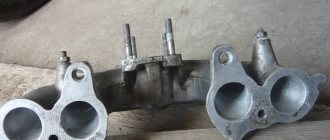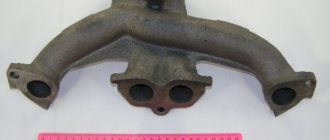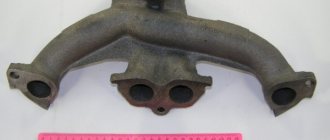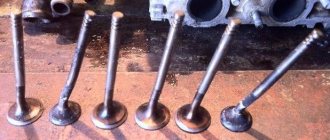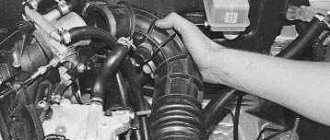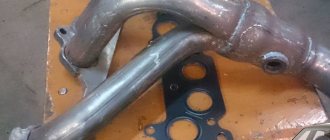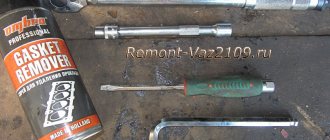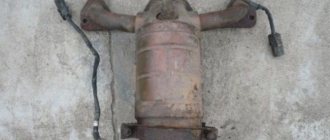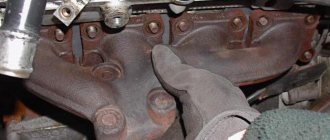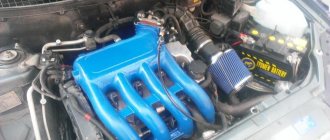Burnout of the gasket under the exhaust manifold is a rather unpleasant and common malfunction on the VAZ 2109.
A product that has become unusable will allow exhaust gases from a running engine to pass under the hood, and the characteristic chattering sound when the engine is under load also does not greatly contribute to a comfortable ride. Replacing the manifold gasket on a VAZ 2109 will help avoid such problems.
The collector gasket is made from a specially compressed asbestos mixture reinforced with steel thread; it can be purchased at any spare parts store. The price of the product, depending on the manufacturer, varies from 50 to 200 rubles. For a VAZ 2109, replacing the intake manifold gasket at a car service center will cost approximately 1,500 rubles and more, not counting the cost of the gasket itself.
Replacing the manifold (exhaust) gasket on a VAZ-2109
A good driver must maintain his car efficiently and in a timely manner, but at the same time always be prepared for the unexpected. Indeed, it is very difficult to control the condition of all the components, parts and gaskets of the machine, which at any moment can fail and stop performing their functions. Thus, one of the most unpleasant “surprises” for car enthusiasts is damage to the exhaust manifold gasket.
Purpose and signs of replacement
The main task of the exhaust manifold gasket is to prevent the gas-air mixture from escaping from the general system. The most common material used for laying is metal or asbestos-free paper. The reason for this precaution is the difficult working conditions, because the gasket has to withstand very high temperature conditions. Consequently, the materials used must have appropriate properties.
Despite its reliability, this gasket often burns out. At the site of damage, exhaust gases come out, which rise upward and seep through the cracks in the hood. It is very difficult not to notice such a malfunction. In addition, the sound of the engine also changes (it becomes louder).
In such a situation, it is enough to inspect the running engine. If the leakage of exhaust gases at the junction of the exhaust manifold is clearly noticeable, then the best solution is to replace the gasket.
Changing the exhaust manifold gasket of a VAZ-2109
I would like to note right away that this work cannot be called very difficult. But its disadvantage is its volume and very significant time costs. So be prepared to set aside a few hours of your personal time. So, the algorithm of actions looks like this:
- Remove the air filter along with the housing. For this:
– unscrew the filter cover fastening (usually it is held on by one screw). If a nut is installed, then use an appropriate open-end or socket wrench to unscrew it;
– lift the lid and put it aside (you won’t need it yet);
- move the air filter aside;
– remove the unit body (to do this, unscrew the four nuts) and also put it aside.
- Remove the carburetor. Here the procedure is a little more complicated:
– prepare the necessary tools – an open-end wrench on “13”, several screwdrivers (it is advisable to have a flathead and a Phillips on hand), a socket on “8” (the deeper the better), a handle with a ratchet and an extension cord;
– discard the commutation from the EKXX valve;
– remove the fuel hoses. To do this, you need to loosen the screws on the mounting clamps and pull the tubes;
– make several turns of the two bolts of the choke cable;
– remove the spring. To do this, simply remove its hook from the damper control rod;
– make several turns of the fastening nut screwed onto the bracket. This will allow the throttle cable to be pulled out;
– pry up the metal cable retainer (if you can’t do it with your finger, you can use a screwdriver);
– pull out the cable, lower it and remove it from the engagement;
– discard the power plugs from the economizer screw sensor;
- remove the hoses connected to the carburetor heating unit;
– pull out the vacuum hose;
– remove the ventilation tube;
– Unscrew the fastening nuts (there are four around the perimeter) and move the carburetor to the side.
- Remove the exhaust manifold. For this:
– prepare the tool – an open-end wrench and a socket set to “13”, a ratchet and a socket set to “10”, an extension cord, a handle with a ratchet. You may also need a wrench;
– remove the fastening nuts that secure the base located under the carburetor and bend it back;
– discard all hoses that are connected to the intake manifold;
– Unscrew the six fastening nuts;
– remove the intake manifold.
- Now you can begin dismantling the exhaust manifold itself. Here is the algorithm of actions:
– prepare a tool (the same as when dismantling the intake manifold);
– Unscrew the four fastening nuts that secure the exhaust manifold and the receiving pipe. If you can’t immediately tighten the rusted nuts, use the life-saving WD-40;
– move the discarded “pants” a little to the side. To do this, just pull them off the studs;
– unscrew the remaining fastening nuts that hold the manifold (we already unscrewed six nuts when dismantling the intake manifold);
– dismantle the exhaust manifold (it should go without any problems);
– now you have reached the exhaust manifold gasket. If it sticks too much, you can carefully pry off the edges with a knife, blade or screwdriver. After that, remove her from her “habitable place.” The view that opens to you is unlikely to be ideal, so additional processing is not necessary;
– apply a cleaning spray to the area where the gasket was, wait a few minutes and clean the surface to perfect condition. If some parts cannot be removed, use a blade or fine-grit sandpaper. As soon as you achieve ideal shine and cleanliness of the surface, you can stop working;
– install a new gasket. At the same time, make sure that all the studs fall into place;
– return all previously dismantled equipment in the reverse order. Pay special attention to the assembly of the carburetor (this is where beginners most often fall asleep);
– start the engine (after complete assembly) and check the quality of the work performed.
Conclusion
Believe me, replacing the exhaust manifold gasket on a VAZ-2109 is not as difficult as it might seem at first glance. The work is voluminous, no doubt, but if you have the tools at hand and free time in reserve, you can handle everything. At the same time, the opportunity to save a little should warm your soul, because at a service station such work will cost at least 2,000 rubles (a very tidy sum). So, when the first signs of malfunction appear, replace it without delay. Good luck.
Collegium of Advocates
The exhaust manifold on a VAZ 2109-2108 most often has to be removed to replace the gasket, because if it burns out, then it starts leaking in this place and the exhaust gases will go under the hood, and the sound of operation will be quite loud. In general, this problem will not lead to anything good.
In order to remove the exhaust manifold, you must first perform the following steps: After this, we will need very few tools, namely: an open-end or socket wrench 13 deep head 13 extension ratchet handle So, first you need to unscrew the 4 nuts securing the exhaust manifold to the pants (intake pipe), which are shown in the photo below: And move the pants a little to the side, pulling them off the pins.
Then you need to unscrew the three remaining nuts securing the manifold, since the remaining 6 were unscrewed when removing the intake manifold. And now you can remove the VAZ 2109-2108 exhaust manifold from the studs without any problems, moving it back: If the gasket is stuck to the cylinder head, you can carefully pry it off with a knife blade or a thin screwdriver, then completely remove it from its seat: After This results in such a rather unpleasant picture: You can remove traces from the old gasket on the surface of the cylinder head using a special spray, applying it to the entire area and waiting at least 15 minutes: The remaining traces can be removed using a thin blade, and you can finally restore it to ideal condition having treated the entire surface with the finest sandpaper, the so-called zero sandpaper.
Symptoms that the exhaust manifold gasket has burnt out.
Full list and action plan »
UncategorizedApril 24, 2022 Symptoms that the exhaust manifold gasket has burned out. Complete list and action plan In this article, we will discuss the symptoms when the exhaust manifold gasket has burned out. For an exhaust device, the gasket is one of the main parts on which the entire correctness and accuracy of the exhaust system will depend.
If the manifold seal is not replaced in a timely manner, the safety conditions for operating the vehicle are greatly reduced. In general, a manifold is a device designed to remove exhaust gases from a car engine. The second function of the collector is to improve the filling of the working chambers and enhance the ventilation of the working space.
All operation of the exhaust device is carried out at elevated temperatures and high gas pressure.
This element is attached directly to the head (cylinder head) and the other side is in contact with the exhaust pipe or converter. The most important task of the exhaust manifold gasket is to prevent exhaust gases from entering the valve space. These gases, in turn, can cause fire of parts or elements of the power unit.
The weak link of the system and signs of its failure Symptoms that the exhaust manifold gasket has burned out can be identified as follows: exhaust gases begin to flow into the car interior or their smell is felt; the car engine begins to start poorly; Strange sounds appear in the engine compartment.
If these ailments are detected, you should begin to inspect the exhaust system.
Repair of the exhaust manifold on a VAZ 2109 (carburetor)
The exhaust manifold is a component of the exhaust system that carries out the process of removing exhaust gases from the cylinders of the power unit into the exhaust pipe.
If the collector malfunctions, the culprit may be either the element itself or its gasket. Replacing the exhaust manifold (exhaust manifold) gasket is a common procedure when repairing a VAZ 2109.
Appearance of the unit
Preparation stages
To replace the manifold or its gasket, in any case you will have to dismantle the VK. But before you get to the element you are looking for, you will first need to go through some preparatory steps. Namely, tighten the fasteners, and then remove the air filter and carburetor if the first stage does not help.
Stage of work
Your actions
Often, loose manifold fastenings caused the entry of contaminants, which disrupted the performance of the exhaust system. If the tightening did not give any result, then the gasket is definitely burned out or the collector itself is damaged, which is less likely
Removing the air filter
Removing the carburetor is carried out in the following sequence:
- Disconnect the coolant supply hose to the engine starting device from the fitting. To do this, unscrew the clamps;
- Be sure to drain the coolant into a prepared container;
- Disconnect the exhaust pipe that comes from the exhaust manifold and the BC bracket;
- Disconnect the throttle cable bracket. To do this, you need to remove one end of the spring from the damper control rod, and then remove the entire spring. Now loosen the nut on the bracket, which will allow you to remove the cable from the engagement;
- Disconnect the EPH sensor from the power plug;
- Disconnect the vacuum tube and a pair of hoses from the carburetor heating unit;
- Remove the engine crankcase ventilation hose;
- Remove the four mounting nuts holding the carburetor and intake manifold;
- Remove the carburetor carefully without yanking. It must be gradually removed from the studs.
VESKO-TRANS.RU
AutoNews / Reviews / Tests
How to Remove the Exhaust Manifold of a VAZ 2109 Injector
The exhaust manifold is part of the exhaust gas metering system, which makes the process of removing exhaust gases from the cylinders of the unit into the exhaust pipe.
If the manifold is not working properly, the culprit is both the element itself and its gasket. Replacement of gasket (exhaust manifold). a common occurrence when performing repairs on a VAZ 2109.
To replace the manifold or gasket, the LCD must be removed in any situation. But until you get there, you will first need to complete a few preliminary steps. Specifically, tighten the fasteners, and then remove the air filter and carburetor if the first step does not help.
Your actions
Often, loose manifold fastenings became a prerequisite for contamination, which led to a malfunction of the exhaust system. In this case, lifting did not give any result, then the gasket or the manifold itself was damaged, which is the least possible
Disassembling the air filter
- If the engine is a fuel injector, you will need to remove the four filter housing cover mounting screws to remove the air filter. Under the cover is the filter itself. If you have trouble lifting the cover, turn off the MAF sensor and remove the filter.
- If there is a carburetor installed under the hood, the filter housing will be held in place by 3 clips. In the center of the iron cover is a screw, often loosened by hand. Removal allows the cover to be lifted easily. Below is a filter that should be removed carefully. Examine its condition carefully. If the filter has been in use for a long time, it is recommended to replace it during assembly.
Dismantling of collectors
Now comes the turn to remove the intake and exhaust manifolds. Having dismantled them, you can understand whether it is possible to get by with replacing the gasket, or whether the collectors themselves will need to be completely replaced.
The gasket is a consumable item, the purchase of which will literally cost you 50-250 rubles, depending on the manufacturer and region. Services for replacing the gasket at a service station cost more than 1,500 rubles. Add to this the cost of a high-quality gasket and you will get quite a lot of money. Such costs can be avoided if you do everything yourself.
Dismantled unit
Intake manifold
By removing the air filter and carburetor, you will gain access to the intake manifold.
To dismantle it you will need a certain set of tools:
- Ratchet with 10mm head;
- Collar;
- Ratchet;
- Deep head 13;
- Regular head 13;
- Open-end wrench 13.
When everything is ready, you can start working.
- Unscrew a couple of mounting nuts to bend back the platform located under the carburetor.
- Disconnect the hoses that are connected to the intake manifold.
- Remove the six mounting nuts located on the intake manifold.
- Remove the manifold itself from the studs. To do this, simply rock the knot to the sides. It often sticks to the gasket, which causes problems with removal.
- Inspect the condition of the unit. If there is damage, the collector must be replaced.
- If the problem is only with the gasket, put the intake manifold aside for now and start removing the outlet.
An exhaust manifold
To dismantle a graduate you will need:
- Ratchet;
- Open-end wrench 13;
- Socket wrench 13;
- Deep head for 13.
All is ready? Then let's get started.
- Unscrew the four exhaust pipe mounting nuts from our exhaust manifold.
- Pull the so-called pants off the heels and take them to the side. Now you can unscrew three more fastening nuts securing the VK.
- Carefully, without sudden movements or jerks, pull the graduate off the stiletto heels.
- It is not uncommon that during the process of dismantling this unit, the manifold or its mounting nuts become stuck to the seats. To prevent this, treat the assembly with WD40 in advance, let it react, after which there will be no problems with dismantling work.
- If the studs break off during removal, you will need to drill out the old element, make a new thread and install a fresh stud.
Pad
Well, the check showed that the burnt gasket was to blame. Therefore, only it will have to be changed.
Pad
Alas, to get to a simple gasket, it was necessary to remove the air filter, carburetor, exhaust, and intake manifolds. But there is no way without this.
To replace an old, used gasket, you will need:
- Remove the old gasket. Here you may face certain difficulties, since most likely the gasket has become properly stuck and burned to the cylinder head;
- Arm yourself with a thin screwdriver, sharp knives, aerosol solvents;
- Spray the surfaces first, then let it react. It’s better to take your time in order to make your work easier;
- When the product takes effect, begin to gradually remove the old gasket from the surface of the block;
- Do not forget to remove carbon deposits from the mating surface of the cylinder block. Here you will no longer need an aerosol, but full-fledged sandpaper. Do not use coarse-grain sheets;
- Install a new gasket for the exhaust and intake manifolds of your VAZ 2109;
- Assembly of the unit is performed in reverse order. That is, first, both manifolds are installed in place, then the carburetor and air filter are returned to their homeland, the fastenings are tightened properly and the result of the work done is checked in practice;
- Of course, don’t forget about the coolant that was drained in the first stages. By the way, this is a great reason to change it to a fresh one.
Installing a new gasket
It is up to you to ensure that the new gasket has a long service life. To do this, before installation, treat the gaskets on both sides with graphite lubricant. This way you will increase the product’s resistance to temperature changes that it regularly encounters. Similarly, coat the cylinder head studs with graphite lubricant for the same purpose.
Basic aspects of manifold tuning
The basis of tuning is polishing inside and out. Thanks to this, you can achieve a neat and attractive appearance. This action improves performance. When the walls in the collector are smooth, gases move through it in one direction without resistance. Faster purging can improve engine cooling.
On VAZ 2109 cars, by polishing the spider, its internal diameter can be increased. Exhaust gas flow increases, as does engine efficiency. Sequence of work:
- Before removing the manifold on a VAZ 2109, you need to dismantle all attachments and disconnect the cylinder head.
- Disassemble the cylinder head, dry out the valves, remove the rocker arms and springs.
- Using the head at “6”, pull out the guides.
- Remove the inlet and outlet devices.
- Eliminate defects (if any) on the cylinder head, exhaust and intake manifold. A spider that is deformed or has obvious damage cannot be installed.
- Mill the block head by 1 mm.
- Wash the cylinder head until it shines. If the gasket is stuck to the block or cylinder head, get rid of its remains without using metal objects.
- After lubricating the valve guides, mount them in place. To work, use an “11” head and a hammer.
- Check the condition of the valves. If there are deformed ones, change them.
- Assemble the head, install rocker arms, caps, valves.
- Reinstall the intake and exhaust manifolds. The manifold gasket must be replaced; an old one cannot be installed.
- Install the cylinder head onto the block using a new gasket and bolts.
The general algorithm for carrying out the work is not very complicated, the main thing is accuracy and precision. Do not trust cylinder head milling to dubious workshops. Otherwise you will have to buy a new one.
Self-replacement of the exhaust and intake manifold gasket on a VAZ 2109
Burnout of the gasket under the exhaust manifold is a rather unpleasant and common malfunction on the VAZ 2109.
A product that has become unusable will allow exhaust gases from a running engine to pass under the hood, and the characteristic chattering sound when the engine is under load also does not greatly contribute to a comfortable ride. Replacing the manifold gasket on a VAZ 2109 will help avoid such problems.
The collector gasket is made from a specially compressed asbestos mixture reinforced with steel thread; it can be purchased at any spare parts store. The price of the product, depending on the manufacturer, varies from 50 to 200 rubles. For a VAZ 2109, replacing the intake manifold gasket at a car service center will cost approximately 1,500 rubles and more, not counting the cost of the gasket itself.
Preliminary work
Replacing the VAZ 2109 intake manifold gasket with your own hands is not very difficult and does not require specific knowledge or expensive tools - the required set of keys is usually present in the trunk of every car enthusiast.
But before replacing, you should try to tighten the fastening of the intake unit - if the gasket is not burned out, it is the loose fastening that may cause exhaust gases to get under the hood. If tightening the fastening does not help, it means that the gasket is completely burned out and needs to be replaced. Replacing the VAZ 2109 manifold gasket will require preliminary work to dismantle the air filter, remove the carburetor and the manifold itself. All of the above work is carried out exclusively on a cold engine.
Removing the air filter with housing
On the injection engine of a VAZ 2109 car, to remove the air filter, it is enough to unscrew the four self-tapping screws securing the cover of the filter element housing - for this, use a 10mm wrench or a ratchet. There will be a filter element under the cover. If the cover is difficult to lift, you can disconnect the mass air flow sensor from the plug.
On a carbureted engine, there are three latches under the hood that can be easily opened. There is a screw in the middle of the metal cover, which can also be unscrewed by hand, after which the cover is removed. Under the cover there is a filter element that must be carefully removed. Subsequently, during reassembly, the filter element can be replaced - if the time has come or if the filter element is very dirty.
Removing the carburetor
After the air filter has been removed, you can begin to remove the carburetor. To remove the carburetor on a VAZ 2109, you will need the following tools:
- two screwdrivers - flat and Phillips;
- 13 open-end wrench;
- head at 8;
- ratchet.
Instructions for dismantling the carburetor will be as follows:
- The coolant supply hose to the carburetor starter is disconnected from the fitting by unscrewing the fastening clamps. The coolant itself is drained into a previously prepared container.
- The exhaust pipe coming from the exhaust manifold and from the cylinder block bracket is disconnected.
- Then the throttle cable bracket is disconnected. To do this, first remove one end of the spring from the throttle control rod, and then remove the entire spring, then loosen the nut on the bracket and remove the cable from its engagement.
- The EPHH screw sensor is disconnected from the power plug.
- Two hoses and a vacuum tube are disconnected from the carburetor heating unit.
- The crankcase ventilation hose is removed.
- Unscrew the 4 nuts securing the carburetor to the intake manifold.
- The carburetor is removed carefully and without jerking - by lifting it from the studs.
The work of removing the carburetor is completed. The presented photos and videos will help you clearly follow the process of removing the carburetor.
Removing the intake manifold
After the work of removing the air filter and dismantling the carburetor is completed, you can begin to remove the intake unit. To do this you will need the following set of tools:
- open-end wrench 13;
- head 13 - regular and deep;
- ratchet and crank;
- ratchet with 10mm head.
The work order will be as follows:
- The platform located under the carburetor is bent back - to do this, two fastening nuts are unscrewed.
- All hoses leading to the manifold are disconnected.
- Six mounting nuts are unscrewed from the intake manifold.
- The intake manifold is removed from the studs - to do this, it should be slightly rocked from side to side, as it can burn to the gasket.
Removing and installing the fuel manifold and injectors
The Multiport Fuel Injection (MFI) system is a device controlled by the ECM. Measure the fraction of fuel under pressure in each cylinder.
The ECM provides control pulses to the fuel injector solenoid.
Fuel enters the top of the injector through the valve ball or needle and a recess in the guide plate as it exits the injector.
The guide plate has 6 holes to control the fuel flow, which form a conical stream of fuel towards the intake valve. The atomized fuel evaporates before entering the combustion chamber.
Conclusion Warning: The fuel system is under pressure. To reduce the risk of injury or fire, relieve fuel system pressure before disconnecting fuel lines.
1. Relieve fuel pressure.
2. Disconnect the “-” battery cable.
3. Remove the fuel injector harness connectors.
4. Remove the EGR valve.
5. Disconnect the power cord.
6. Remove the fuel manifold mounting bolts.
Before removing the fuel manifold, spray clean it according to the instructions provided.
Replacing the gasket
After the preparatory work is completed - the air filter, carburetor and intake and exhaust manifold are dismantled, you can begin the main work, for which all previous steps were done - directly replacing the gasket itself.
The work order will look like this:
- We remove the old gasket - this can be difficult, since, most likely, it is tightly burned to the cylinder head - in this case, you need to use a thin screwdriver or knife. To make the work easier, you can use special aerosol solvents in cans, sold in auto parts stores. It is also necessary to carefully remove carbon deposits from the mating surface of the block - you can use sandpaper for this.
- The new product is installed on the exhaust manifold, then all work is done in the reverse order. Replacing the intake manifold gasket on a VAZ 2109 is carried out in a similar way.
Replacement of the exhaust manifold gasket on the VAZ 2109 has been completed. The exhaust pipe of the muffler is secured with brass nuts, preferably new ones. And don't forget to fill in the coolant that was drained when dismantling the carburetor!
Tools and necessary parts
To remove the exhaust manifold on a VAZ 2114 in order to replace the gasket or entire part, you will need the following tool:
- open-end and ring wrenches for 8, 10, 13, 17;
- wrench with heads 17, 19;
- screwdrivers, pliers.
It is also a good idea to have tools such as a Dremel, nut saw or nut pick on hand. As a rule, the fasteners on the exhaust system parts stick tightly.
A few days before your planned repair, begin treating accessible nuts with WD-40 or another penetrating lubricant. Repeat the operation 2-3 times. This will make the task of removing the manifold a little easier. .
The question often arises: is it worth using a sealant after removing and replacing the gasket? Experts believe that if you apply sealant to the gasket, it should only be high-quality silicone. A bad sealant can bring a lot of trouble to a VAZ 2114 engine: when it burns out, it turns into “pellets” that are pulled into the crankcase. And this is unnecessary contamination of the piston system.
Self-replacement of the exhaust and intake manifold gasket on a VAZ 2109
Burnout of the gasket under the exhaust manifold is a rather unpleasant and common malfunction on the VAZ 2109.
A product that has become unusable will allow exhaust gases from a running engine to pass under the hood, and the characteristic chattering sound when the engine is under load also does not greatly contribute to a comfortable ride. Replacing the manifold gasket on a VAZ 2109 will help avoid such problems.
The collector gasket is made from a specially compressed asbestos mixture reinforced with steel thread; it can be purchased at any spare parts store. The price of the product, depending on the manufacturer, varies from 50 to 200 rubles. For a VAZ 2109, replacing the intake manifold gasket at a car service center will cost approximately 1,500 rubles and more, not counting the cost of the gasket itself.
Preliminary work
Replacing the VAZ 2109 intake manifold gasket with your own hands is not very difficult and does not require specific knowledge or expensive tools - the required set of keys is usually present in the trunk of every car enthusiast.
But before replacing, you should try to tighten the fastening of the intake unit - if the gasket is not burned out, it is the loose fastening that may cause exhaust gases to get under the hood. If tightening the fastening does not help, it means that the gasket is completely burned out and needs to be replaced. Replacing the VAZ 2109 manifold gasket will require preliminary work to dismantle the air filter, remove the carburetor and the manifold itself. All of the above work is carried out exclusively on a cold engine.
Removing the air filter with housing
On the injection engine of a VAZ 2109 car, to remove the air filter, it is enough to unscrew the four self-tapping screws securing the cover of the filter element housing - for this, use a 10mm wrench or a ratchet. There will be a filter element under the cover. If the cover is difficult to lift, you can disconnect the mass air flow sensor from the plug.
On a carbureted engine, there are three latches under the hood that can be easily opened. There is a screw in the middle of the metal cover, which can also be unscrewed by hand, after which the cover is removed. Under the cover there is a filter element that must be carefully removed. Subsequently, during reassembly, the filter element can be replaced - if the time has come or if the filter element is very dirty.
Removing the carburetor
After the air filter has been removed, you can begin to remove the carburetor. To remove the carburetor on a VAZ 2109, you will need the following tools:
- two screwdrivers - flat and Phillips;
- 13 open-end wrench;
- head at 8;
- ratchet.
Instructions for dismantling the carburetor will be as follows:
- The coolant supply hose to the carburetor starter is disconnected from the fitting by unscrewing the fastening clamps. The coolant itself is drained into a previously prepared container.
- The exhaust pipe coming from the exhaust manifold and from the cylinder block bracket is disconnected.
- Then the throttle cable bracket is disconnected. To do this, first remove one end of the spring from the throttle control rod, and then remove the entire spring, then loosen the nut on the bracket and remove the cable from its engagement.
- The EPHH screw sensor is disconnected from the power plug.
- Two hoses and a vacuum tube are disconnected from the carburetor heating unit.
- The crankcase ventilation hose is removed.
- Unscrew the 4 nuts securing the carburetor to the intake manifold.
- The carburetor is removed carefully and without jerking - by lifting it from the studs.
The work of removing the carburetor is completed. The presented photos and videos will help you clearly follow the process of removing the carburetor.
Removing the intake manifold
After the work of removing the air filter and dismantling the carburetor is completed, you can begin to remove the intake unit. To do this you will need the following set of tools:
- open-end wrench 13;
- head 13 - regular and deep;
- ratchet and crank;
- ratchet with 10mm head.
The work order will be as follows:
- The platform located under the carburetor is bent back - to do this, two fastening nuts are unscrewed.
- All hoses leading to the manifold are disconnected.
- Six mounting nuts are unscrewed from the intake manifold.
- The intake manifold is removed from the studs - to do this, it should be slightly rocked from side to side, as it can burn to the gasket.
Removing the exhaust manifold
Removing the VAZ 2109 exhaust manifold will require the following tools:
- wrenches 13 - open-end and cap;
- deep head at 13;
- ratchet.
- The four nuts securing the exhaust pipe are unscrewed from the manifold.
- The “pants” are pulled off the studs and moved to the side, then the remaining three nuts securing the manifold are unscrewed.
- The exhaust manifold is carefully and without jerking removed from the studs.
When removing the collectors, a problem may arise such as sticking of the studs and nuts - since the metal is constantly heating and cooling, a souring process occurs.
To make work easier, the fastening studs can be filled with WD 40 liquid in advance, about a day before starting work. This will make it much easier to remove the manifold for subsequent gasket replacement.
If the pin breaks off when unscrewing, you just have to drill it out, and then cut a new thread and screw on a new pin.
conclusions
Replacing the exhaust manifold gasket on a VAZ-2114 engine is a rather complicated and difficult task, which can become a serious challenge for many novice car enthusiasts. But if you follow the instructions, everything will work out. Well, if not, then the direct route is to a car service center. Particular attention should be paid to the quality of the product so that you do not have to change the part after several thousand kilometers.
Symptoms:
sucks air into the engine cylinders, intake noise is heard from under the hood; exhaust gases burst under the hood.
Possible reason:
the intake manifold (manifold) gaskets are worn out; The exhaust manifold gasket is worn.
Tools:
one set of wrenches, one set of sockets, one set of screwdrivers.
1. Place the car on an inspection hole or overpass.
2. Drain the engine cooling system.
3. Disconnect the exhaust manifold and front exhaust pipe.
4. Remove the air filter housing from the vehicle.
5. Disconnect the pneumatic drive rod from the carburetor, then disconnect the throttle valve drive cross rod from it.
6. Remove the battery. This is optional, but recommended to improve access to other parts and fasteners.
7. Using a 13-inch socket wrench, remove the lower nut securing the air intake.
8. Using a 13-inch socket wrench, unscrew the top nut securing the air intake, then remove it from the vehicle.
9. Remove the top nut holding the starter heat shield in place.
10. Using a 13-inch socket wrench, unscrew the lug lock nut, then remove it.
11. Using a 13-inch socket wrench, remove the nut securing the ground wire, then remove the ground wire from the stud (the timing chain tensioner has been removed for clarity).
12. Using a 10 mm wrench, remove the two nuts securing the coolant inlet hose to the coolant pump, then disconnect the hose. When reinstalling, replace this gasket with a new one.
13. Using a 13-inch socket wrench with an extension, remove the seven nuts that secure the intake manifold to the exhaust manifold. Please note that under the intake and exhaust manifold hinge nuts, washers are installed that are slightly thicker than the others (the attached photo shows the mounting locations for the intake manifold and exhaust manifold).
14. Disconnect the intake manifold from the engine head by removing the first stud from the second stud. Then move the manifold to the side.
15. Remove the exhaust manifold from the cylinder head studs.
A good driver must maintain his car efficiently and in a timely manner, but always be prepared for the unexpected. After all, it is very difficult to check the condition of all the components, parts and seals of the machine, which at any moment can fail and stop performing their functions. Therefore, one of the most unpleasant “surprises” for motorists is damage to the exhaust manifold gasket.
Replacing the gasket
After the preparatory work is completed - the air filter, carburetor and intake and exhaust manifold are dismantled, you can begin the main work, for which all previous steps were done - directly replacing the gasket itself.
The work order will look like this:
- We remove the old gasket - this can be difficult, since, most likely, it is tightly burned to the cylinder head - in this case, you need to use a thin screwdriver or knife. To make the work easier, you can use special aerosol solvents in cans, sold in auto parts stores. It is also necessary to carefully remove carbon deposits from the mating surface of the block - you can use sandpaper for this.
- The new product is installed on the exhaust manifold, then all work is done in the reverse order. Replacing the intake manifold gasket on a VAZ 2109 is carried out in a similar way.
Self-replacement of the exhaust and intake manifold gasket on a VAZ 2109
Burnout of the gasket under the exhaust manifold is a rather unpleasant and common malfunction on the VAZ 2109.
The collector gasket is made from a specially compressed asbestos mixture reinforced with steel thread; it can be purchased at any spare parts store.
The price of the product, depending on the manufacturer, varies from 50 to 200 rubles.
For a VAZ 2109, replacing the intake manifold gasket at a car service center will cost approximately 1,500 rubles and more, not counting the cost of the gasket itself.
Preliminary work
Replacing the VAZ 2109 intake manifold gasket with your own hands is not very difficult and does not require specific knowledge or expensive tools - the required set of keys is usually present in the trunk of every car enthusiast.
But before replacing, you should try to tighten the fastening of the intake unit - if the gasket is not burned out, it is the loose fastening that may cause exhaust gases to get under the hood.
If tightening the fastening does not help, it means that the gasket is completely burned out and needs to be replaced. Replacing the VAZ 2109 manifold gasket will require preliminary work to dismantle the air filter, remove the carburetor and the manifold itself.
All of the above work is carried out exclusively on a cold engine.
Removing the air filter with housing
On the injection engine of a VAZ 2109 car, to remove the air filter, it is enough to unscrew the four self-tapping screws securing the cover of the filter element housing - for this, use a 10mm wrench or a ratchet. There will be a filter element under the cover. If the cover is difficult to lift, you can disconnect the mass air flow sensor from the plug.
On a carbureted engine, there are three latches under the hood that can be easily opened. There is a screw in the middle of the metal cover, which can also be unscrewed by hand, after which the cover is removed.
Under the cover there is a filter element that must be carefully removed. Subsequently, during reassembly, the filter element can be replaced - if the time has come or if the filter element is very dirty.
Removing the carburetor
After the air filter has been removed, you can begin to remove the carburetor. To remove the carburetor on a VAZ 2109, you will need the following tools:
- two screwdrivers - flat and Phillips;
- 13 open-end wrench;
- head at 8;
- ratchet.
Instructions for dismantling the carburetor will be as follows:
- The coolant supply hose to the carburetor starter is disconnected from the fitting by unscrewing the fastening clamps. The coolant itself is drained into a previously prepared container.
- The exhaust pipe coming from the exhaust manifold and from the cylinder block bracket is disconnected.
- Then the throttle cable bracket is disconnected. To do this, first remove one end of the spring from the throttle control rod, and then remove the entire spring, then loosen the nut on the bracket and remove the cable from its engagement.
- The EPHH screw sensor is disconnected from the power plug.
- Two hoses and a vacuum tube are disconnected from the carburetor heating unit.
- The crankcase ventilation hose is removed.
- Unscrew the 4 nuts securing the carburetor to the intake manifold.
- The carburetor is removed carefully and without jerking - by lifting it from the studs.
The work of removing the carburetor is completed. The presented photos and videos will help you clearly follow the process of removing the carburetor.
Removing the intake manifold
After the work of removing the air filter and dismantling the carburetor is completed, you can begin to remove the intake unit. To do this you will need the following set of tools:
- open-end wrench 13;
- head 13 - regular and deep;
- ratchet and crank;
- ratchet with 10mm head.
The work order will be as follows:
- The platform located under the carburetor is bent back - to do this, two fastening nuts are unscrewed.
- All hoses leading to the manifold are disconnected.
- Six mounting nuts are unscrewed from the intake manifold.
- The intake manifold is removed from the studs - to do this, it should be slightly rocked from side to side, as it can burn to the gasket.
Removing the exhaust manifold
Removing the VAZ 2109 exhaust manifold will require the following tools:
- wrenches 13 - open-end and cap;
- deep head at 13;
- ratchet.
- The four nuts securing the exhaust pipe are unscrewed from the manifold.
- The “pants” are pulled off the studs and moved to the side, then the remaining three nuts securing the manifold are unscrewed.
- The exhaust manifold is carefully and without jerking removed from the studs.
When removing the collectors, a problem may arise such as sticking of the studs and nuts - since the metal is constantly heating and cooling, a souring process occurs.
To make work easier, the fastening studs can be filled with WD 40 liquid in advance, about a day before starting work. This will make it much easier to remove the manifold for subsequent gasket replacement.
If the pin breaks off when unscrewing, you just have to drill it out, and then cut a new thread and screw on a new pin.
After the preparatory work is completed - the air filter, carburetor and intake and exhaust manifold are dismantled, you can begin the main work, for which all previous steps were done - directly replacing the gasket itself.
The work order will look like this:
- We remove the old gasket - this can be difficult, since, most likely, it is tightly burned to the cylinder head - in this case, you need to use a thin screwdriver or knife. To make the work easier, you can use special aerosol solvents in cans, sold in auto parts stores. It is also necessary to carefully remove carbon deposits from the mating surface of the block - you can use sandpaper for this.
- The new product is installed on the exhaust manifold, then all work is done in the reverse order. Replacing the intake manifold gasket on a VAZ 2109 is carried out in a similar way.
Replacement of the exhaust manifold gasket on the VAZ 2109 has been completed. The exhaust pipe of the muffler is secured with brass nuts, preferably new ones. And don't forget to fill in the coolant that was drained when dismantling the carburetor!
Care instructions
In order for the new gasket to last as long as possible, before installation it is recommended to cover the product with a layer of graphite lubricant on both sides - this will extend the service life of the material and increase the tightness, and will also help avoid burning. It is also recommended to coat the cylinder head studs with a layer of graphite lubricant.
Your lawyer
I didn't find any antifreeze in the cylinder block. :/ I suspect that it leaked into the crankcase. I unscrewed the stud using a nut cutter, clamped it and slowly turned it out.
I assembled everything, started it, warmed it up - it doesn’t hold the idle speed, and the timing belt is burning, I’ll look into it. And so, rushing like an airplane (flying, only, low) I felt, after the broken gasket, that I had gone deaf!
As it turned out, the main thing is not to lose faith!
I'm afraid that there is antifreeze in the crankcase, does anyone know how to check?
_Lelik_ 05 Jul 2009
Systemus July 06, 2009 Look at the oil on the dipstick.
If it has whitish inclusions, then there is antifreeze in the oil. When cold, there are no inclusions, the oil does not separate, when starting the engine and running for 5 minutes.
Very small inclusions appear (they look like bubbles - possibly antifreeze). I'll change the oil. I didn’t change the oil. Everything ingenious is simple, the idle speed was due to an unconnected air sensor.
Everything became normal. The check engine light burned a little and went out.
And happiness came to me. The repairs were done according to the Murzilka ZR. What is not included in the gasket replacement description: 1.
When dismantling the intake pipe (pants), you need to disconnect the lambda probe from the terminal. The nuts on the bracket of the pants were stuck to death - the bracket had to be cut off with a hacksaw blade, a new one costs 150 rubles.
2. Drain about 5 liters of antifreeze so that the flooded cylinder block does not cause excruciating pain.
3. To disconnect/attach the intake manifold
Removing the VAZ 2109 injector manifold. Removing, replacing, installing exhaust manifold gasket
A gasket consisting of several layers is installed under the VAZ 2109 exhaust manifold. For various reasons (uneven tightening of nuts, aging), it fails and requires replacement.
The first sign of burnout is the appearance of a characteristic noise. Yes, you can drive if you don’t spare your ears.
But it is better to replace it in a timely manner, since ignition in the engine compartment is possible. The gasket is made of pressed asbestos, which is reinforced with steel thread.
We recommend reading: Extension of the deadline for placing an auction from a request
The price of such a gasket, depending on the store and manufacturer, ranges from 50-200 rubles. The cost of replacement in car services is not less than 1000 rubles.
And this does not take into account the cost of gaskets, nuts, and other components that may require replacement. Therefore, it will be much more effective to do the repairs yourself, saving a decent amount. Before replacing the manifold gasket, it is necessary to understand how the process itself proceeds.
You don't need special tools or the experience of a great 80-level mechanic.
A standard set of tools that are found in every garage is sufficient. The work procedure can be briefly divided into several stages: removing the air filter; dismantling the air filter housing; removing the carburetor;
Signs of a malfunction of the cylinder head
There are several reasons for the head gasket to burn out on VAZ cars:
- motor overheating;
- poor tightening of cylinder head bolts;
- crack in the block head;
- deformed surface of the cylinder head or cylinder block.
The main cause of burnout of the cylinder head is overheating; the engine temperature is determined by the sensor on the instrument cluster. The engine can overheat due to various factors:
- insufficient level of antifreeze (antifreeze) in the cooling system;
- the ignition is set incorrectly (too late);
- the main cooling radiator is clogged;
- Intake and exhaust valves are jammed.
If there is severe overheating, the cylinder head may fail and the piston rings may become stuck. If, after replacing the cylinder head, the gasket burns out again, it is necessary to carry out more serious repairs and deal with the cause of the recurring defect.
|
How to replace the exhaust pipe on VAZ 2108-VAZ 21099 cars?
Removal: 1) First disconnect the resonator from the exhaust pipe of the car. (see “Disconnecting the resonator from the exhaust pipe of the car”, point “3-4”)
2) Then, using a wrench, unscrew the two nuts securing the upper bracket.
3) Next, after unscrewing all the nuts, remove the upper bracket from the exhaust pipe of the car.
4) Next, move to the lower bracket, and then unscrew its two retaining bolts in the same way.
5) And then remove the lower bracket from the downpipe of the car.
Note! After removing the upper and lower brackets, check whether there is an oxygen sensor on the exhaust pipe. If there is one, then unscrew the nut that holds it to the exhaust pipe of the car! (How to unscrew the sensor retaining nut and then remove it from the car pipe, see the article: “Replacing the oxygen sensor”, point “3”)
6) Now bend back the locking plates of all four nuts securing the exhaust pipe.
7) And after bending the plates, unscrew all four nuts securing the pipe, using an extension with a cap head.
Note! Replace the burnt or deformed metal gasket with a new one!
Installation: 1) First, install a metal gasket on the mating surface of the new receiving pipe, and then, together with the gasket, install the receiving pipe in its place by tightening all four nuts that secure it.
Note! It is recommended to replace the exhaust pipe mounting nuts with new ones!
